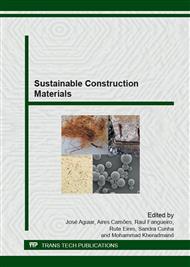[1]
H.V. Sloot, Environmental efficiency of immobilization techniques for wastes in relation to utilization and disposal, in: Actes du Congrès International Sur Les Procédés de Solidification et de Stabilisation des Déchets, Société Alpine de Publications, Grenoble, 1997, pp.327-337.
DOI: 10.4267/dechets-sciences-techniques.588
Google Scholar
[2]
ABNT. NBR 10. 005, Procedimento para obtenção de extrato lixiviado de resíduos sólidos. Rio de Janeiro, (2004).
Google Scholar
[3]
ABNT. NBR 10. 004, Resíduos Sólidos. Rio de Janeiro, (2004).
Google Scholar
[4]
A.L.F. de Brito, Protocol of evaluation of materials resulting from stabilization by solidification of wastes, PhD Dissertation, Environmental Engineering, Federal University of Santa Catarina, UFSC, Florianópolis, SC, Brazil, 2007. [In Portuguese. ].
DOI: 10.17140/aftnsoj-5-157
Google Scholar
[5]
Information on http: /www. inmet. gov. br.
Google Scholar
[6]
H.H. Murray, Applied clay mineralogy today and tomorrow, Clay Minerals Middlesex 34 (1999) 39-49.
DOI: 10.1180/000985599546055
Google Scholar
[7]
S. Bordeepong et al., Mineralogy, Chemical Composition and Ceramic Properties of Clay Deposits in Southern Thailand, Nat. Sci. Delaware 46 (2012) 485-500.
Google Scholar
[8]
G.P. Souza, J.N.F. Holanda, Sintering behavior of clay masses containing waste from the oil industry, Cerâmica São Paulo 49 (2003) 311. [In Portuguese. ].
Google Scholar
[9]
L. Duarte et al., Applications of scanning electron microscopy (SEM) and energy dispersive x-ray detector in the study of gems: Brazilian examples. Pesquisas em Geociências Porto Alegre 30 (2003) 3-15. [In Portuguese. ].
Google Scholar
[10]
P.K. Mehta, P.J. Monteiro, Concret: structure, properties and materials, Pini, São Paulo, 1994. [In Portuguese. ].
Google Scholar
[11]
H.V. Sloot, J.J. Dijkstra, Development of Horizontally Standardized Leaching Tests for Construction Materials: A Material Based or Release Based Approach? Identical leaching mechanisms for different leaching materials, ENC: Energy Commission of the Netherlands -C-04-060, Petten, 2004. Information on http: /www. ecn. nl/publications.
Google Scholar
[12]
J.C.C. Pureza, Use of low grain size industrial waste in red clay: environmental and technological aspects, MSc Dissertation, Mining, Metallurgical and Material Engineering, Federal University of Rio Grande do Sul, UFRGS, Porto Alegre, RS, 2004. [In Portuguese. ].
DOI: 10.32467/issn.2175-3628v23n1a14
Google Scholar
[13]
T. M. Basegio, Immobilization of chromium ion from the ash of leather waste in ceramic products, PhD Dissertation, Mining, Metallurgical and Material Engineering, Federal University of Rio Grande do Sul, UFRGS, Porto Alegre, RS, 2004. [In Portuguese. ].
DOI: 10.32467/issn.2175-3628v23n1a14
Google Scholar
[14]
NEN 7345, Determination of Release of Inorganic Constituents From Construction Material and Stabilized Waste products, Netherlands, (1995).
Google Scholar
[15]
C.S. Poon, Z.Q. Chen, Comparison of the Characteristics of Flow-Through and Flow-Around Leaching Tests of Solidified Heavy Metal Wastes, Chemosphere Amsterdam 38 (1999) 663.
DOI: 10.1016/s0045-6535(98)00203-3
Google Scholar
[16]
M.A. da Rosa, Characterization of the incorporation of stainless steel scrap in ceramic materials in terms of chromium incorporation, MSc Dissertation, Mining, Metallurgical and Material Engineering, Federal University of Rio Grande do Sul, UFRGS, Porto Alegre, RS, 2001. [In Portuguese. ].
DOI: 10.32467/issn.2175-3628v23n1a14
Google Scholar
[17]
D.C.C. Dal Molin, Experimental techniques for the study of microstructures, in: G. Cechella Isaia (Ed. ), Construction materials and scientific principles of material engineering, Ibracon, São Paulo, 2007, pp.403-436. [In Portuguese. ].
Google Scholar
[18]
C.S. Kazmierczak, Red clay products, in: G. Cechella Isaia (Ed. ), Construction materials and scientific principles of material engineering, Ibracon, São Paulo, 2007, pp.563-585. [In Portuguese. ].
Google Scholar
[19]
R. Prikryl, et al., Spatial relationships of salt distribution and related physical changes of underlying rocks on naturally weathered sandstone exposures Bohemian Switzerland National Park. Environmental Geology, Czech Republic 52 (2006).
DOI: 10.1007/s00254-006-0589-2
Google Scholar


